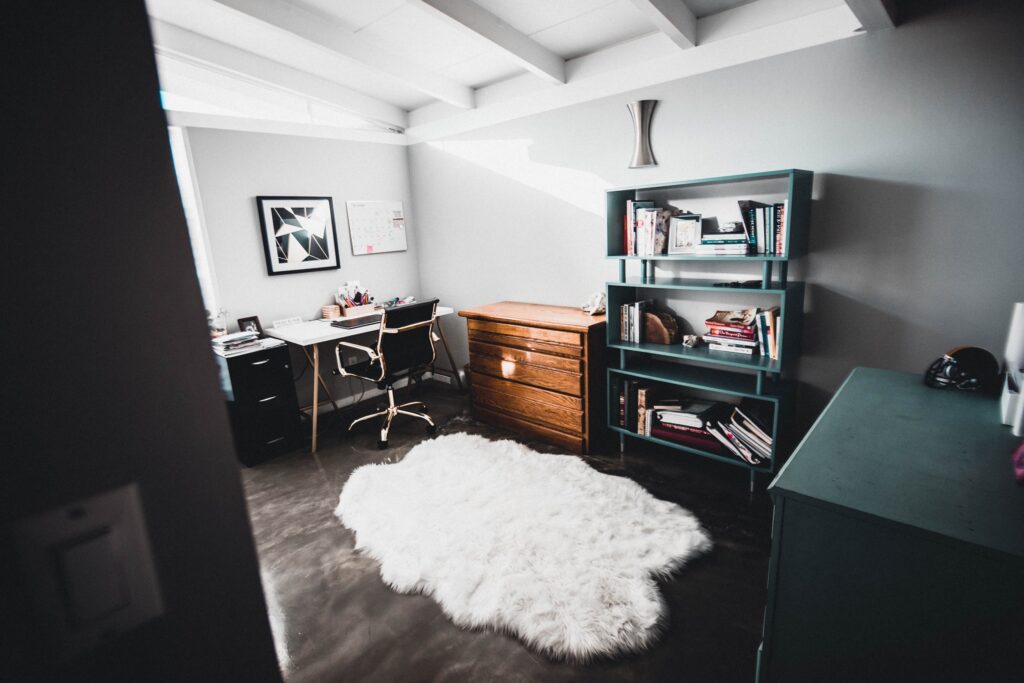Working from home is becoming increasingly popular with more and more people choosing to set up a home office. But what do you do if your only available room or workspace placement is in a room with no windows?
A windowless home office is not ideal for most. But you can actually make it work and thrive in using it.
In this article, I’ll explore the challenges of a windowless home office and provide you with tips on how to transform it into a space you love dearly.
Working from home has become a new norm in today’s world. While it has its benefits, it also comes with its own set of challenges.
One of the most significant challenges is setting up a home office, let alone a windowless room. Before we delve into tips on how to make a windowless home office work for you, let’s first discuss the challenges you may face.
Lack of Natural Light
The most significant – and obvious – challenge of a windowless home office is the lack of natural light. Natural light is essential, not just for our physical health but also for our mental well-being. It helps regulate our sleep-wake cycle, boosts our vitamin D levels, and improves our mood. Lack of exposure to sunlight can lead to feelings of fatigue and depression. It can also affect our productivity and creativity.
Sunlight is really a mood enhancer. It stimulates the production of serotonin, often referred to as the ‘feel-good’ hormone. This can lead to an uplift in mood, potentially sparking creativity and problem-solving skills, essential for productivity. Without natural light, you might struggle with feelings of lethargy, reduced productivity, and a lack of mental clarity.
And let’s not forget about the positive effect sunlight has on our eyes. It’s less straining than artificial light and promotes healthier vision. In a windowless room, you could experience eye strain, discomfort, and over time, potential vision problems.
Also, a lack of natural sunlight makes it hard for plants to grow naturally in your office. To counter that, you can choose fake plants or plants thriving in low light.
In a nutshell, the lack of natural light can be a real issue. But there are ways to counter it. We’ll get to that.
Limited Ventilation
Another hurdle to overcome in a windowless room is limited ventilation. When air circulation is poor, it can affect the room’s overall air quality. In this type of environment, you might experience a build-up of pollutants, dust, and allergens. Over time, exposure to such conditions can lead to headaches, trigger allergies, and cause respiratory problems. It could also lead to a stuffy, uncomfortable environment that might distract you from your work.
It’s not really the best when talking about creating a nice and safe workspace at home.
The importance of fresh air in any working environment, particularly in your home office where you spend several hours a day, cannot be overstated. Fresh air doesn’t just provide oxygen for us to breathe. It also helps to keep our minds clear, increases our ability to concentrate, and even boosts energy levels.
Ever felt lazy when working from home for no particular reason? It might be that you have not gotten enough fresh air.
A well-ventilated room can also assist in regulating temperatures and reducing excess humidity, contributing to a more comfortable and healthier workspace. Therefore, while a windowless office presents the challenge of limited ventilation, it’s essential to explore alternatives to ensure you’re working in an environment that promotes not just productivity but also your overall health and well-being.
Feeling of Confinement
Spending hours in a windowless room can sometimes lead to a feeling of confinement or claustrophobia, a sense that the walls are closing in on you. This can result in discomfort and even increased stress levels, which are hardly conducive to productivity or creativity.
The lack of windows, coupled with unchanging scenery, might make it seem as if the walls are gradually closing in on you. This sensation can be quite discomforting, potentially increasing stress levels and impacting your overall productivity and mental well-being.
Hence, it’s crucial to address this issue when setting up a windowless home office.

How to Maximize Lighting in Your Windowless Office
Working in a windowless office can be challenging because of the lack of natural light. But it doesn’t have to be a dark and dreary space. With a few simple adjustments, you can create a bright and inviting workspace that will help you stay focused and productive throughout the day.
Here is how you can maximize the lighting in your windowless home office.
Choosing the Right Artificial Light Sources
When it comes to selecting artificial light sources, there are a few things to keep in mind.
- First, be sure to choose bulbs with a high color rendering index (CRI). A high CRI ensures that the colors in your workspace appear as close to natural light as possible, which can help to reduce eye strain and fatigue.
- In addition to a high CRI, you should also consider the color temperature of your bulbs. Daylight bulbs, which have a color temperature of around 5000K, are a great option for windowless offices as they mimic the natural light of the sun.
- Finally, consider investing in dimmable lights so that you can adjust the brightness according to your needs. This can be especially helpful if you work long hours or if you need to adjust the lighting for different tasks throughout the day.
Go With Light-Reflecting Surfaces
Another way to create a brighter workspace is to utilize light-reflecting surfaces. A white ceiling, for example, can help to bounce light around your room and create a more open and airy feel. Similarly, painting your walls a light color and adding mirrors can also help to reflect light and create a brighter space.
When it comes to selecting furniture and decor, consider opting for materials that are light in color and reflect light well. Glass or metal desks, for example, can help to reflect light and create a brighter workspace.
Some people prefer their home office to be dark and moody. However, if you don’t want the be sure to choose a bright color scheme to bring even more light into your windowless space.
How to Create a Balanced Lighting Scheme
Finally, it’s important to have a balanced lighting scheme in your windowless office. A mix of overhead lighting, task lighting, and accent lighting can help to create a bright and inviting workspace.
- Overhead lighting, such as ceiling fixtures, can help to provide general illumination throughout your space.
- Task lightings, such as desk lamps or under-cabinet lighting, can help to provide focused illumination for specific tasks.
- Accent lightings, such as wall sconces or floor lamps, can help to add depth and dimension to your space.
By incorporating these tips into your windowless office, you can create a bright and inviting workspace that will help you stay focused, productive, and energized throughout the day.
If you want more lighting ideas you can get them here.

How to enhance Ventilation and Air Quality
Good air quality is essential when working in a windowless room. Poor air quality can lead to health issues such as headaches, fatigue, and respiratory problems.
Here are some tips to improve the air quality in your workspace:
Investing in an Air Purifier
An air purifier can help to remove harmful pollutants and allergens from the air, leading to cleaner, fresher air. This can be especially helpful for people who suffer from allergies or asthma. When choosing an air purifier, be sure to consider the size of your room and the type of pollutants you want to remove.
Some air purifiers are designed to remove specific pollutants, such as cigarette smoke or pet dander, while others are more general. Look for an air purifier with a HEPA filter, which can capture particles as small as 0.3 microns.
Another benefit of using an air purifier is that it can help to reduce unpleasant odors in your workspace. This can be particularly useful if you work in a shared space or if your workspace is located near a source of strong odors, such as a kitchen, laundry room, or bathroom.
Incorporating Plants for Cleaner Air
Plants are natural air purifiers and can help to improve the air quality in your workspace. They can also add a touch of greenery and life to an otherwise sterile environment.
Consider adding a few plants to your desk, such as peace lilies or snake plants, which are known for their air-cleaning qualities.
In addition to improving the air quality, plants can also have a positive impact on your mood and productivity. Studies have shown that being around plants can help to reduce stress and increase feelings of well-being.
So, not only will incorporating plants into your workspace helps to improve the air quality, but it can also help you to feel better overall. You can find the best plants for your home office here.
Ensuring Proper Air Circulation
Proper air circulation is crucial when working in a windowless room. Without proper ventilation, pollutants can build up in the air, leading to poor air quality and potential health problems. Be sure to open your windows in nearby rooms or use a fan to create a constant flow of fresh air. You should also try to keep your workspace clean and clutter-free to prevent the buildup of dust and other allergens.
If you don’t have access to a window or if opening a window isn’t an option, consider using a fan or air circulator to help move the air around. This can help to prevent stagnant air and improve the overall air quality in your workspace.
In addition to improving the air quality, proper air circulation can also help to regulate the temperature in your workspace. This can be particularly important if you work in a space that gets hot or stuffy, as it can help to keep you comfortable and focused.
By following these tips, you can help to improve the air quality and ventilation in your windowless workspace. Not only will this help to protect your health, but it can also help you to feel more comfortable and productive throughout the day.

Designing an Inspiring and Comfortable Workspace With no Windows
Creating an inspiring and comfortable workspace is crucial for productivity and overall well-being. Whether you work from home or in an office, having a workspace that you love can make a significant difference in your work performance and mental health.
When you have a windowless home office, this task becomes increasingly harder.
Selecting the Right Furniture
When selecting furniture for your workspace, it’s essential to choose pieces that are both functional and comfortable. Your chair and desk should be ergonomically designed to suit your specific needs. An ergonomic chair can help to improve your posture and reduce discomfort and pain, while a desk with the right height can prevent eye and neck strain.
Additionally, it’s important to consider the materials of your furniture. Opt for high-quality and durable pieces that can withstand daily wear and tear. Investing in good furniture can save you money in the long run and provide you with a comfortable and inspiring workspace for years to come.
Personalizing Your Space with Decor
What is the main problem with a home office with no windows? It can seem very uninspiring. Hence, you need to add something inspiring to it. Art and personal touches can do just that.
Adding personal touches to your workspace can help to create a space that feels welcoming and inspiring. Consider incorporating artwork, photos, or plants into your desk to make the space your own.
Plants add a pop of color and life to your workspace. Artwork and photos can help to create a positive and motivating environment. Choose pieces that inspire you and reflect your personality and interests.
Replace Windows with Mirrors
What is the thing that comes closest to resembling a window? I’d say it’s a mirror.
Mirrors do more than just provide a place for a quick appearance check before a video call. They can be a secret weapon in your design arsenal. By reflecting light, they not only amplify any light sources you have in the room, making it brighter but also create the illusion of extra space. The reflection gives a sense of depth that can make a small, windowless room feel larger and more open.
Incorporating mirrors in strategic places can help to trick the eye into perceiving more space than there actually is, combating that feeling of confinement. This can have really great effects on your enjoyment when working from home in your home office.
However, they are just one of the many clever design solutions you can use to transform a windowless workspace into an inviting, comfortable, and productive environment.
Conclusion: Get Ready to Enjoy Your Windowless Home Office
Working in a windowless room can be a challenge, yes, but it’s not impossible to create a workspace that is functional and comfortable. By maximizing lighting, enhancing ventilation and air quality, and designing an inspiring and comfortable workspace, you can make a windowless home office work for you.
Actually, you can make it just as inviting and functional as an office with windows. You just need a bit more effort.
In conclusion, designing an inspiring and comfortable workspace requires careful consideration of furniture, ergonomics, and decor. By creating a windowless workspace that is tailored to your needs and preferences, you can improve your productivity, creativity, and overall well-being.
My name is Frederik
I am a passionate marketeer who loves the freedom that comes with working from home whenever I choose to do so.
I love getting nerdy with every single detail about making everything related to my home just a tiny bit better.
That is what motivates me to write about home stuff on this blog.
-
Frederik Fisker Waehrenshttps://myeasyhomelife.com/author/frederik-fisker-waehrens/
-
Frederik Fisker Waehrenshttps://myeasyhomelife.com/author/frederik-fisker-waehrens/
-
Frederik Fisker Waehrenshttps://myeasyhomelife.com/author/frederik-fisker-waehrens/
-
Frederik Fisker Waehrenshttps://myeasyhomelife.com/author/frederik-fisker-waehrens/


